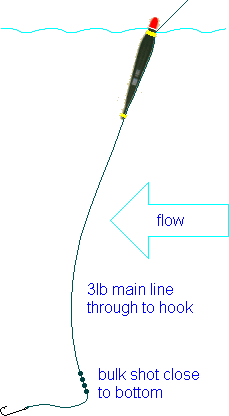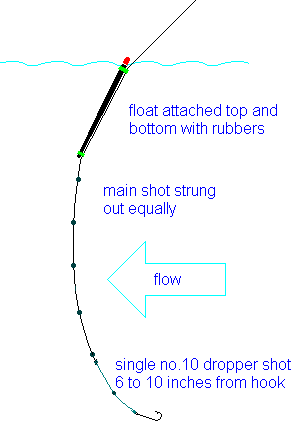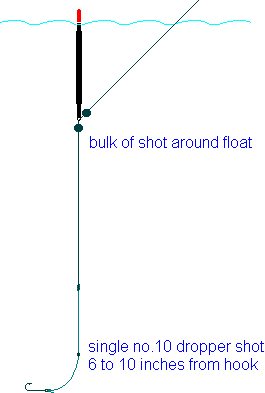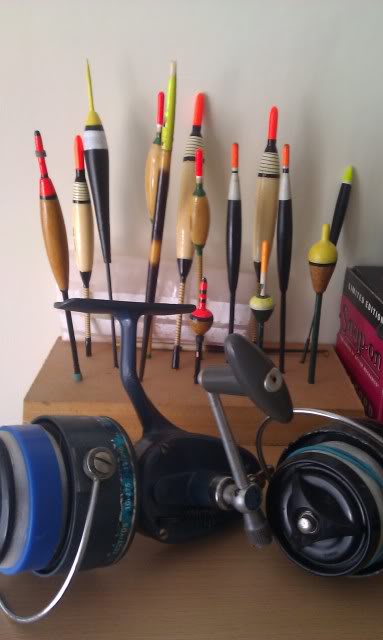Float Rig Guide
2 posters
Page 1 of 1
 Float Rig Guide
Float Rig Guide
Float Rig Guide
Chubber Float Rig
Float fishing - probably the most popular coarse angling method, used effectively in both running and still water. This sub-section is to include detailed information on each variation of float fishing (except pole fishing, which warrants its own section). At first this will be a brief overview of the most popular styles, growing with the site to a more in-depth reference document.

The chubber float is ideal for fast flowing river fishing, often with big baits for sizable chub and barbel. With the bulk of the shot close to the hook the bait can be presented on or close to the river bed in fast water. Don't bother with fine hooklengths in snaggy swims, fish the main line straight through to the hook. Step up the size of line if there are barbel feeding in the area. Use big baits such as meat, worms or large bunches of maggots, the smellier baits like cheese paste and flavoured meats work well in coloured water.
Lift Method

A very enjoyable method for catching bottom feeding fish such as carp, tench, bream and crucians. Attach a waggler to the main line using a float rubber. Place a shot large enough to pull the float under 6 to 8 inches from the hook. Slide the float up or down the line until just the tip is showing. When a fish takes the bait it will either swim off dragging the float under or lift the shot of the lake bed causing the float to lift up higher in the water.
Stick Float

Stick float fishing is only used on flowing water, specifically at short range. It is a suitable method for all but the very fastest of flows, the diagram above showing the basics of the usual set-up. More of the shot can be positioned closer to the hook when fishing in a fast flowing stretch of river. To avoid tangles on casting it is good pratice to 'check' the line by slowing the rate gradually to a stop with a finger as it peels of the reel just before the float hits the water, thus stringing the rig out in a straight line. As a stick float is attached top and bottom by float rubbers it is possible to slow the float or even stop it by holding back on feeding off line. This gives a greater control over the bait than that achieved by waggler fishing and also keeps the line tight between rod and float ready for the strike. Line mending may also be necessary to achieve this tight line and avoid bows.
Waggler, River

Fishing a waggler set-up in a river is ideal for slower, deeper stretches of water or where distance casting is required. String the shot out equally down the line with a small shot close to the hook so that the hook-bait sinks in a natural manner and is not just carried along with the flow near the surface. Start off fishing as close as possible to the river bed without snagging and shorten the rig as necessary if the target fish are feeding up in the water. Line must be payed off the reel and kept on the surface so that the float is not held back and pulled under. A 'mending' of the line may be necessary depending upon the flow to stop an excess of line forming a bow on the surface and reducing the chances of a hit when striking. A bow in the line can also pull the float of course, hold it back or pull it under.
Waggler, Stillwater

Stillwater waggler fishing is very popular and the set-up shown above, with the bulk of the shot around the float is top of the list. Place a single dropper shot between 6 and 10 inches from the hook to assist bite detection. Do not hesitate to alter the location of this shot and the depth of the rig if bites are hard to hit. A good starting point is to fish the bait on or just off the bottom. Shortening to find the fish if necessary - bites are usually harder to hit the higher up in the water you are fishing. If you are receiving a lot of bites 'on the drop', as the bait is sinking to its natural position then distributing the shot along the line will sink the bait quicker, that is if you choose to bypass the fish in the upper levels of water. Distributing the shot is also useful if the water has a significant undertow. Use a float with a fine tip for sensitive bite detection if the weather conditions and tow will allow it.
Chubber Float Rig
Float fishing - probably the most popular coarse angling method, used effectively in both running and still water. This sub-section is to include detailed information on each variation of float fishing (except pole fishing, which warrants its own section). At first this will be a brief overview of the most popular styles, growing with the site to a more in-depth reference document.

The chubber float is ideal for fast flowing river fishing, often with big baits for sizable chub and barbel. With the bulk of the shot close to the hook the bait can be presented on or close to the river bed in fast water. Don't bother with fine hooklengths in snaggy swims, fish the main line straight through to the hook. Step up the size of line if there are barbel feeding in the area. Use big baits such as meat, worms or large bunches of maggots, the smellier baits like cheese paste and flavoured meats work well in coloured water.
Lift Method

A very enjoyable method for catching bottom feeding fish such as carp, tench, bream and crucians. Attach a waggler to the main line using a float rubber. Place a shot large enough to pull the float under 6 to 8 inches from the hook. Slide the float up or down the line until just the tip is showing. When a fish takes the bait it will either swim off dragging the float under or lift the shot of the lake bed causing the float to lift up higher in the water.
Stick Float

Stick float fishing is only used on flowing water, specifically at short range. It is a suitable method for all but the very fastest of flows, the diagram above showing the basics of the usual set-up. More of the shot can be positioned closer to the hook when fishing in a fast flowing stretch of river. To avoid tangles on casting it is good pratice to 'check' the line by slowing the rate gradually to a stop with a finger as it peels of the reel just before the float hits the water, thus stringing the rig out in a straight line. As a stick float is attached top and bottom by float rubbers it is possible to slow the float or even stop it by holding back on feeding off line. This gives a greater control over the bait than that achieved by waggler fishing and also keeps the line tight between rod and float ready for the strike. Line mending may also be necessary to achieve this tight line and avoid bows.
Waggler, River

Fishing a waggler set-up in a river is ideal for slower, deeper stretches of water or where distance casting is required. String the shot out equally down the line with a small shot close to the hook so that the hook-bait sinks in a natural manner and is not just carried along with the flow near the surface. Start off fishing as close as possible to the river bed without snagging and shorten the rig as necessary if the target fish are feeding up in the water. Line must be payed off the reel and kept on the surface so that the float is not held back and pulled under. A 'mending' of the line may be necessary depending upon the flow to stop an excess of line forming a bow on the surface and reducing the chances of a hit when striking. A bow in the line can also pull the float of course, hold it back or pull it under.
Waggler, Stillwater

Stillwater waggler fishing is very popular and the set-up shown above, with the bulk of the shot around the float is top of the list. Place a single dropper shot between 6 and 10 inches from the hook to assist bite detection. Do not hesitate to alter the location of this shot and the depth of the rig if bites are hard to hit. A good starting point is to fish the bait on or just off the bottom. Shortening to find the fish if necessary - bites are usually harder to hit the higher up in the water you are fishing. If you are receiving a lot of bites 'on the drop', as the bait is sinking to its natural position then distributing the shot along the line will sink the bait quicker, that is if you choose to bypass the fish in the upper levels of water. Distributing the shot is also useful if the water has a significant undertow. Use a float with a fine tip for sensitive bite detection if the weather conditions and tow will allow it.
 Re: Float Rig Guide
Re: Float Rig Guide
I love float fishing that goes for silver fish,Carp even pike i think there is something great about watching that bob then pull down of the float.
Sitting in my office i have a selection of old floats the good old Perch bobber that was my first choice for virtually all my fishing when i was about 8..
the good old quill and later on some very nice hand made Andy Batchelor ones that acquired of of ken (Longshot) a few years back that i'm still to scared to use...

Sitting in my office i have a selection of old floats the good old Perch bobber that was my first choice for virtually all my fishing when i was about 8..
the good old quill and later on some very nice hand made Andy Batchelor ones that acquired of of ken (Longshot) a few years back that i'm still to scared to use...


Stotty- Site Gaffer !

-

Number of posts : 12673
Age : 53
Location : Essex Boy!
Reputation : 348
Registration date : 2008-03-15
My Bait : get on the bait Zone
 Similar topics
Similar topics» lift method float fishing or sunken float
» preparing particles time guide
» Woodchuckers guide to lure fishing.
» Float fishing trotting
» float for ledgering ?
» preparing particles time guide
» Woodchuckers guide to lure fishing.
» Float fishing trotting
» float for ledgering ?
Page 1 of 1
Permissions in this forum:
You cannot reply to topics in this forum